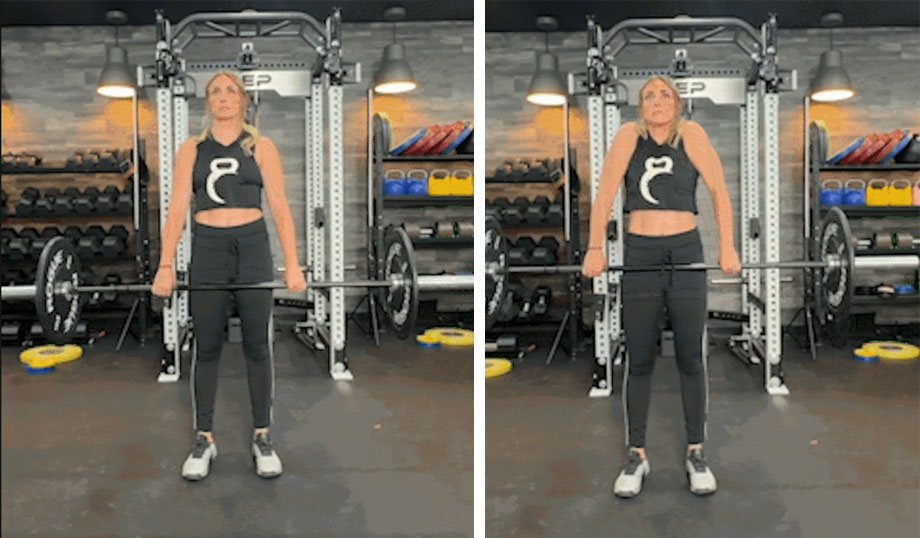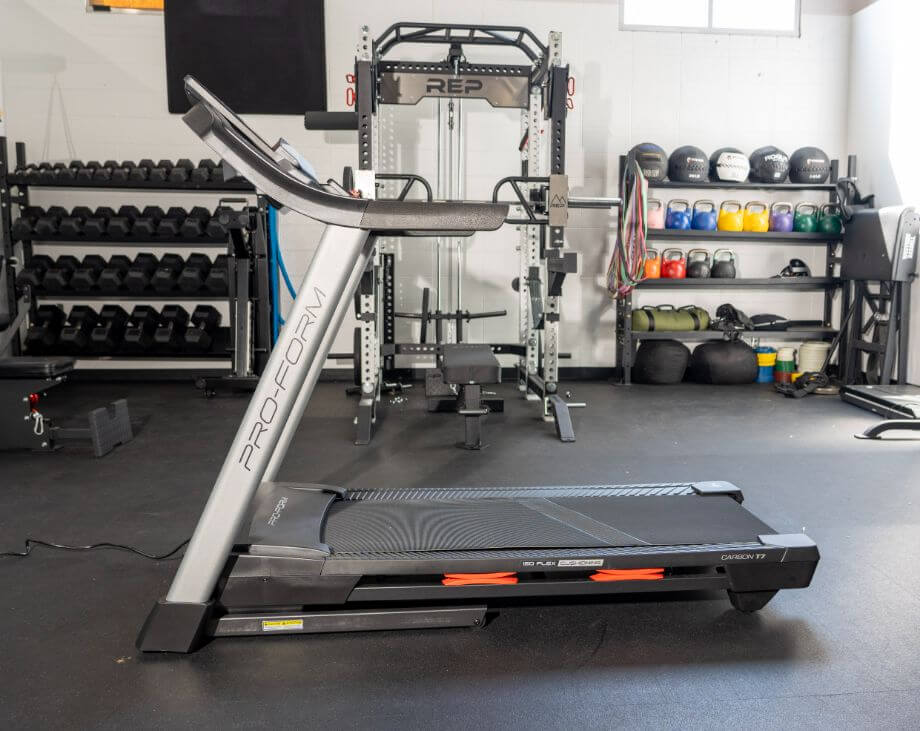Some of the best exercises involve small movements that mimic what we do in our everyday lives. That’s the idea behind the barbell shrug, a simple shoulder lift movement that can help build muscle, strength, and power in your upper body.
They’re indispensable if you’re looking to build bigger traps, but that’s not all; doing barbell shrugs on the reg may translate to better performance on other weightlifting movements, including deadlifts, squats, carries, and Olympic lifts.
Kate Meier, NASM-CPT, USAW-L1, CF-L1, and GGR director of fitness content, discusses how to do shrugs with perfect form, along with variations, alternatives, benefits, and more. Check it out below!
How To Do the Shrug Exercise
You can do the shrug exercise using a variety of implements, but we’re focusing on the classic barbell version for this tutorial. Because of the relatively small range of motion, you can go heavier than you would on other lifts, as long as you don’t overdo it.
How to do it:
- Load a barbell to your desired weight.
- Grip the bar using a shoulder-width overhand grip.
- Lean forward slightly, keeping your back straight.
- Lift and drive your shoulders up toward your ears.
- Squeeze your shoulders and upper back muscles at the top of the movement.
- Pause, then slowly lower the barbell back down to the starting position.
- Repeat for reps.
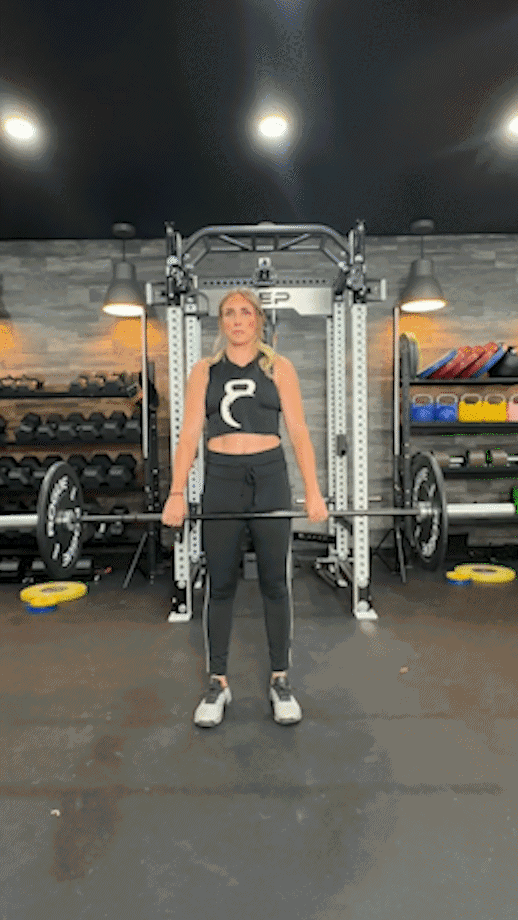
Modifications
- Dial it back: Swapping your barbell for one of the best trap bars provides more stability due to its unique shape, making the movement more beginner-friendly.
- Make it harder: Loading up the plates is one way to intensify the effect of your barbell shrugs, but you can also try a behind-the-back barbell shrug to target your traps in a different way. The highly technical overhead shrug exercise is also an option, but we’d recommend getting the professional guidance of a certified personal trainer for these.
How To Do Shrugs At Home
One of the best things about the shrug exercise is that you don’t need a fully-kitted home gym to get the job done. You can perform the movement just as easily using dumbbells, kettlebells, a resistance band, or even heavy household objects.
Shrug Variations
- Dumbbell shrug: The dumbbell shrug replaces the barbell with dumbbells to allow for a fuller range of motion, but lifters often find it harder to use progressively heavier weights.
- Trap-bar shrug: The trap bar’s unique shape allows you to maintain better posture and use a neutral grip, meaning you’ll perform more effective, efficient reps at lower weights.
- Kettlebell shrug: Like dumbbells, using one or two of the best kettlebells for your shrugs lets you work with a larger range of motion. It also allows you to choose front or side shrugs to effectively shift the muscle activation from the upper trapezius and serratus anterior to the middle traps, levator scapulae, and erector spinae.
- Cable shrug: Free weights are great, but switching to the cable machine changes the type of resistance, helping break progress plateaus.
- Seated shrug: Seated barbell shrugs are cumbersome for some lifters, but the seated positioning offers stability that really lets you isolate your upper back and shoulders.
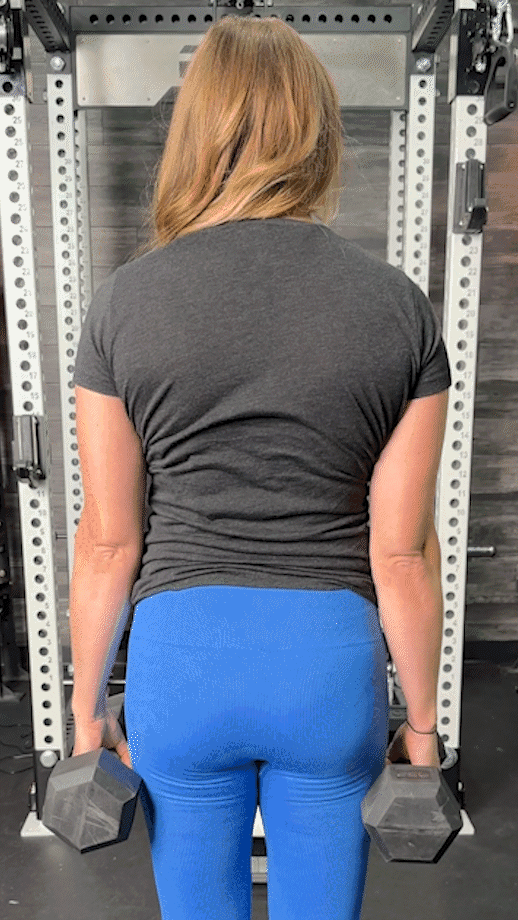
Shrug Alternatives
Your strength training should include more than barbell shrugs if your goal is to build big traps and upper-back muscles. Here’s a handful of shrug alternatives to give you options for your upper-body workout routine.
Barbell Deadlift
Why do it: “Although it’s often classified as a back exercise, the barbell deadlift is one of the best full-body compound exercises,” says Kate Meier, NASM-CPT, USAW-L1, CF-L1. “This lift hits muscle groups everywhere, including the traps, lats, core, glutes, quads, hamstrings, and lower back.”
How to do it:
- Stand over a loaded barbell with your feet hip-width apart, toes slightly turned out, chest tall, back straight, and eyes tracking forward.
- Hinge forward and bend your knees so you can reach down and grip the barbell using a mixed or double overhand grip.
- Drive through your heels and extend your knees and hips simultaneously to stand up.
- Continue until your hips are at full extension.
- Squeeze your glutes, then reverse the movement to return the barbell to the floor.
- Repeat for reps.
RELATED: Deadlift: Muscles Worked
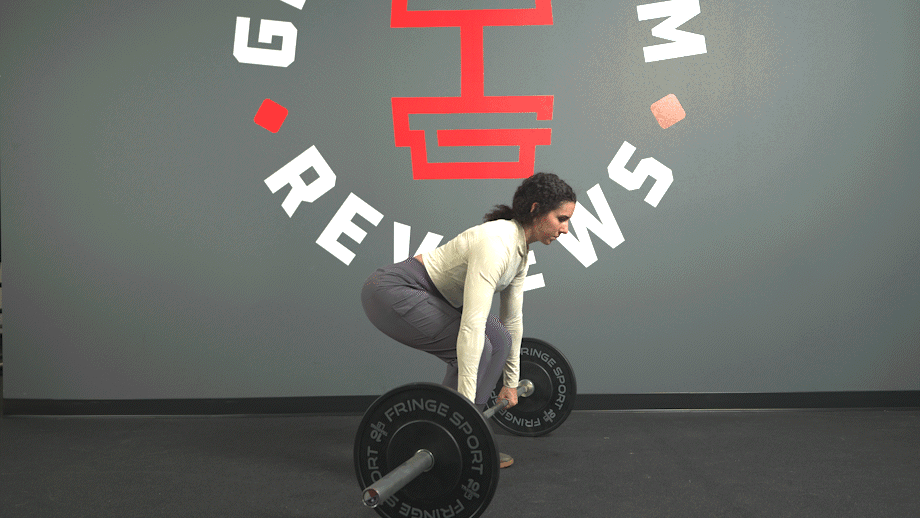
Barbell Bent-Over Row
Why do it: The barbell bent-over row is a total back builder, targeting your lats, upper and middle traps, rhomboids, and posterior delts. Used in conjunction with barbell shrugs, you’ll get muscle activation virtually everywhere throughout your shoulders and back.
How to do it:
- Stand over a loaded barbell with your feet shoulder-width apart.
- Hinge forward and bend your knees to grip the barbell with a double overhand grip.
- Deadlift the bar toward your waist, keeping your arms fully extended in front of you.
- Push your hips back to angle your torso forward, keeping your back straight, so that the bar is hanging roughly at knee height. (This is your starting position.)
- Engage your lats and pull the bar towrd your sternum.
- Pinch your shoulder blades at the top, then slowly guide the weight back down.
- Repeat for reps.
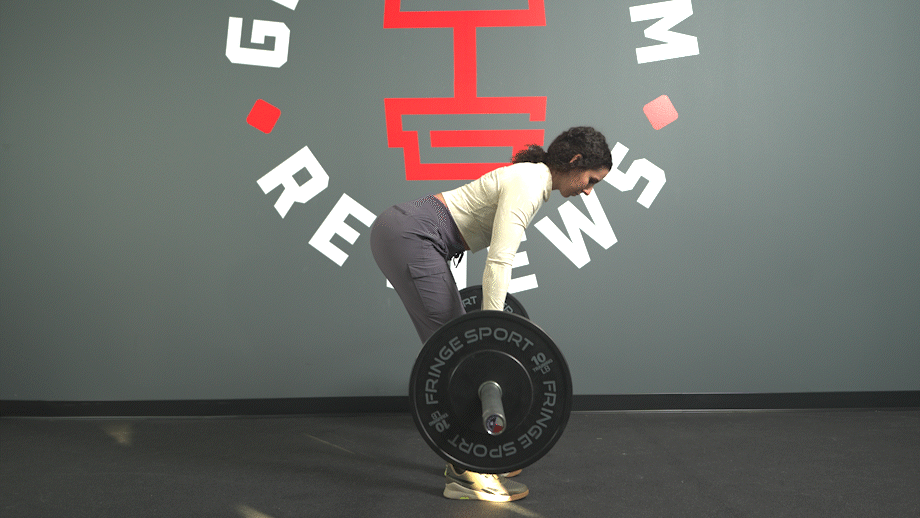
Farmer’s Carry
Why do it: The farmer’s carry is another compound exercise that wreaks havoc (in a good way) on muscle groups from head to toe. It’s also highly functional since most of us have stuff to lug around every day, training the same muscles you use to carry groceries, gym/work bags, suitcases, and more.
How to do it:
- Stand with good posture and a dumbbell or kettlebell held in each hand.
- Begin walking in a straight line, keeping your core braced and your torso upright.
- Continue for the desired distance or duration, then place the weights down and rest.
- Reset and repeat for reps.
RELATED: What Is Functional Fitness?
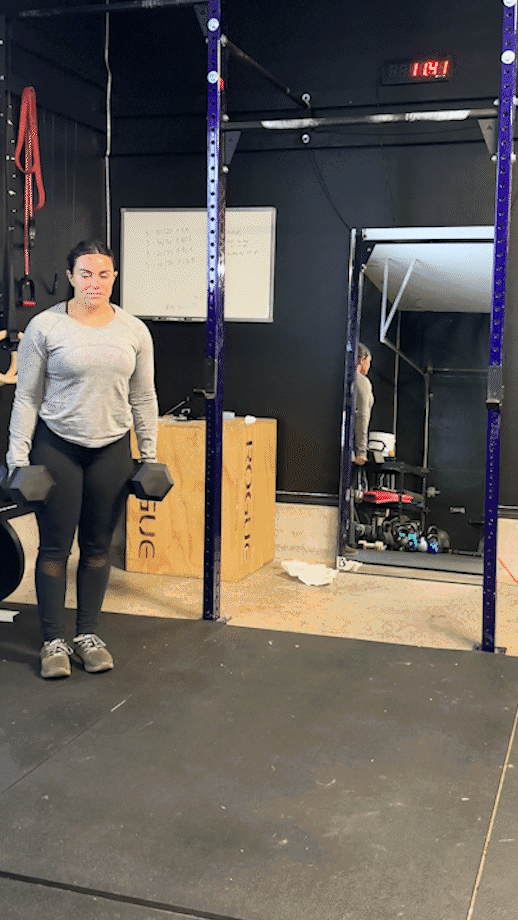
Face Pull
Why do it: “The face pull is one of the best isolation exercises for your upper traps, rear delts, and rhomboids,” says Kate. “Face pulls also involve externally rotating at the shoulder joint in the end position, which strengthens the rotator cuff muscles and improves shoulder stability.”
How to do it:
- Adjust a cable machine to shoulder height and attach the rope attachment.
- Grip the rope and step back to create tension.
- Pull the rope toward your face, standing with your feet shoulder-width apart, your core muscles tight, your neck and spine neutral, and your eyes looking forward.
- Split your hands apart at the end of the movement so that you have a hand on either side of your head. Pinch your shoulder blades and squeeze the contraction.
- Pause, then slowly return to the starting position.
- Repeat for reps.
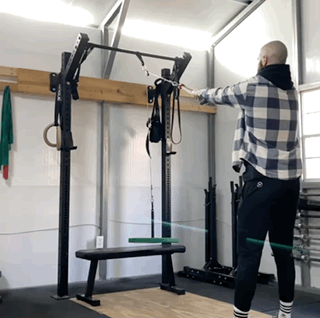
Incline Row
Why do it: Want to get even more upper-back muscle isolation? The incline row uses an incline bench to stabilize your upper body, so you can really dig in and go heavy for greater gains.
How to do it:
- Adjust your weight bench to approximately 45 degrees of incline.
- Grab two dumbbells and set them on the floor on either side of the bench.
- Sit down, pressing your chest into the support pad.
- Grip your dumbbells using an overhand or neutral grip.
- Pull the dumbbells into your body, pinching your shoulder blades together at the top of the movement.
- Squeeze the contraction, then slowly bring the dumbbells back down toward the floor.
- Repeat for reps.
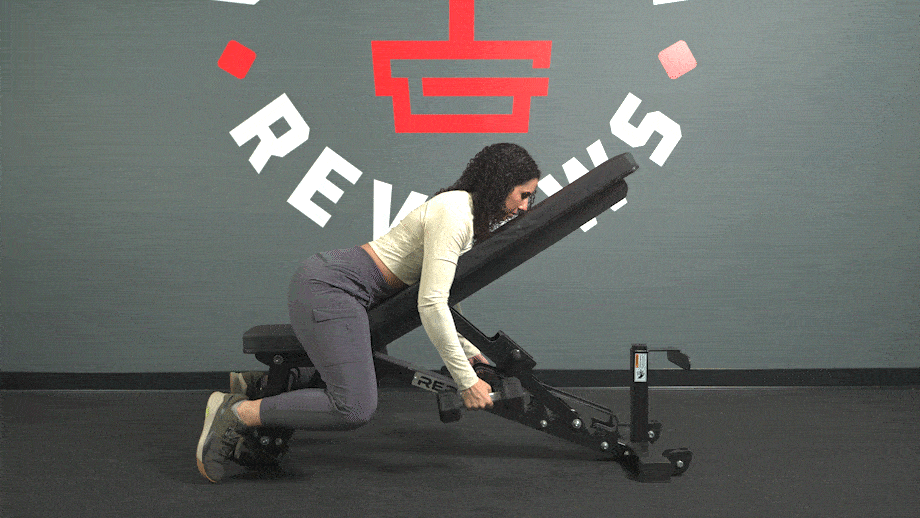
Benefits of Shrugs
As we’ve established, the barbell shrug can heavily target your shoulders and upper-back muscles, resulting in strength and hypertrophy gains, but what other benefits should lifters expect from doing shrugs?
May Improve Shoulder Function
According to the Journal of Orthopaedic and Sports Physical Therapy1, the unilateral shoulder shrug exercise produced the greatest EMG activity in the upper trapezius.
Since the trapezius and serratus anterior are among the most important muscles for maintaining proper shoulder function, a strength training program that includes the shrug exercise or shrug variations may help improve shoulder function and promote shoulder health.
A more recent study published in Clinical Biomechanics2 confirmed these findings, taking things a step further to suggest that shrug exercises may address conditions like scapular dyskinesis by “[facilitating] upward rotation of the scapula by strengthening the upper trapezius muscle.”
May Reduce Neck Pain
According to the Mayo Clinic Proceedings3, neck pain affects more than 30% of the population annually, making it the fourth leading cause of disability worldwide.
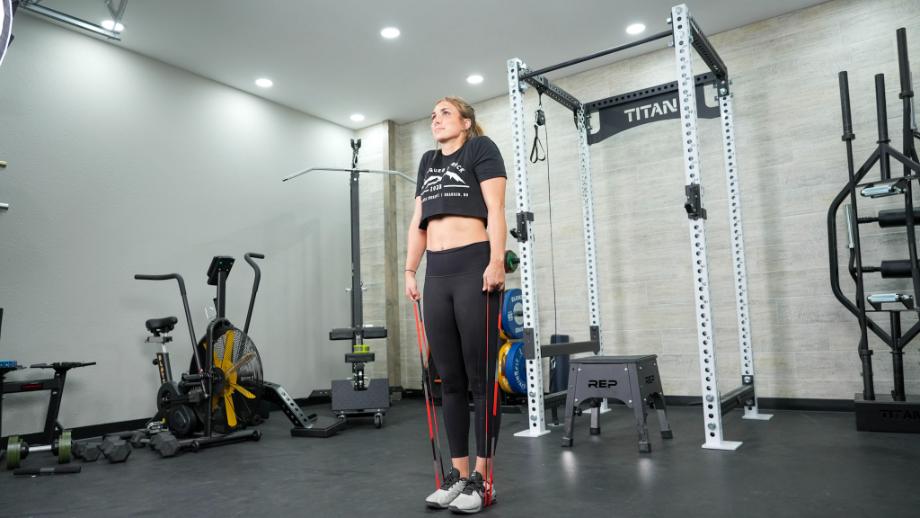
Further, Medical Sciences4 found that patients with chronic non-specific neck pain who performed neck exercises, including shoulder shrugs, experienced improved neck proprioception (the body’s ability to sense movement) and reduced neck pain and disability after eight weeks.
Exercises like the barbell shrug may benefit individuals with chronic non-specific neck pain. But for some, they can exacerbate the issue. Always discuss your symptoms with your doctor or other qualified healthcare professional before incorporating exercises that may adversely affect your condition.
May Enhance Olympic Weightlifting Performance
“When you’re performing Olympic lifts like the snatch or the clean and jerk, you need to perform an explosive shrug movement to propel the bar upward into the overhead lockout position,” says Kate Meier, NASM-CPT, USAW-L1, CF-L1. “Performing barbell shrugs to supplement your Olympic weightlifting program strengthens the upper traps, which facilitates this movement and supports upward scapular rotation.”
A study by the Journal of Strength and Conditioning Research5 confirmed this, stating that the “trapezius muscle activity appears to work to maintain scapular position, especially in the first pull and transition phases” of Olympic weightlifting movements.
Common Shrug Mistakes
The barbell shrug is one of the best exercises for targeting the upper trapezius muscle, but you may increase your risk of injury if you’re not doing it right. Here are a few common mistakes to avoid while getting in your barbell shrug repetitions.
Rolling Your Shoulders
“One of the most common mistakes I see beginners make when learning the barbell shrug is rolling their shoulders,” says Kate. “The ideal movement is straight vertical, which activates the upper traps and other surrounding muscles without subjecting the body to undue stress.”
Rolling your shoulders is ineffective and can be dangerous since this motion shifts the emphasis off of your upper traps and onto your rotator cuff muscles. This diminishes your gains and may cause or contribute to a rotator cuff injury. Keep your shrugs strictly vertical to avoid this.
Using Too Much Momentum
The range of motion on the shrug exercise is pretty minimal, involving only straight vertical movement from your shoulders. At lighter weights, that’s no biggie. Things get trickier when you start racking up tons of plates on the barbell.
“Your shoulders should shrug, but you want the rest of your body still when you’re doing your reps,” says Kate. “Otherwise, you risk using momentum or even other muscle groups to bear the brunt of the workload, defeating the purpose of the exercise.”
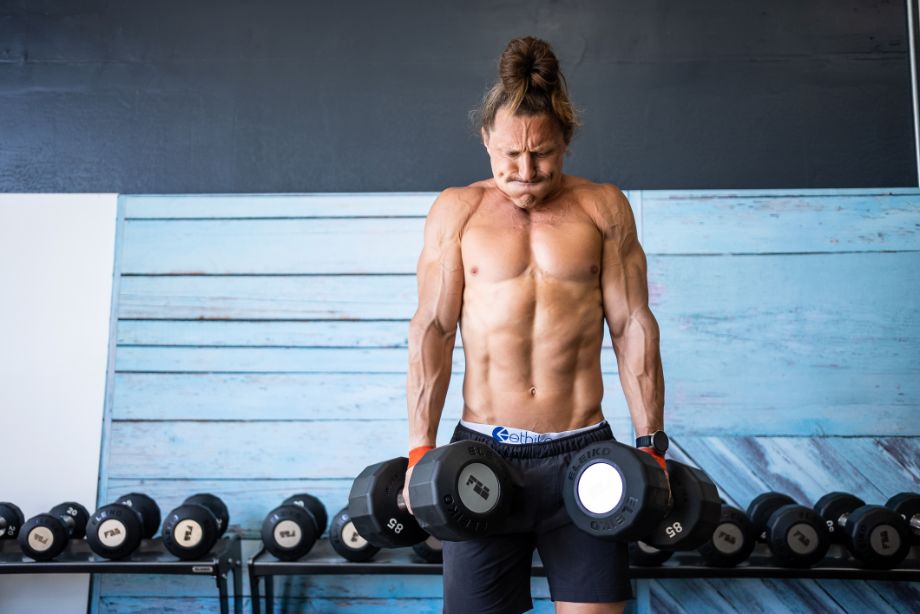
So, get into position—back straight, core braced, eyes looking forward—and don’t budge as you shrug. If you find a hard time maintaining this positioning or exclusively using your shoulders and back to shrug, you may be going too heavy.
Rounding Your Back
“Speaking of proper body positioning, your back and neck should be neutral while doing barbell shrugs,” says Kate. “Rounding your back happens when you’ve gone a touch too heavy on the weight and now it’s pulling your shoulders forward, overloading the lumbar, and putting your spine at risk.”
Progressive overload is the path to making gains, but you should never lift weights that are impossible for you to move while maintaining perfect form. Your form must always come first, so reduce how much weight you’re taking on until each rep is letter-perfect.
Muscles Worked by Shrugs
The barbell shrug is an upper-body dominant exercise that hits various muscle groups in your shoulders and back. The main muscles involved include:
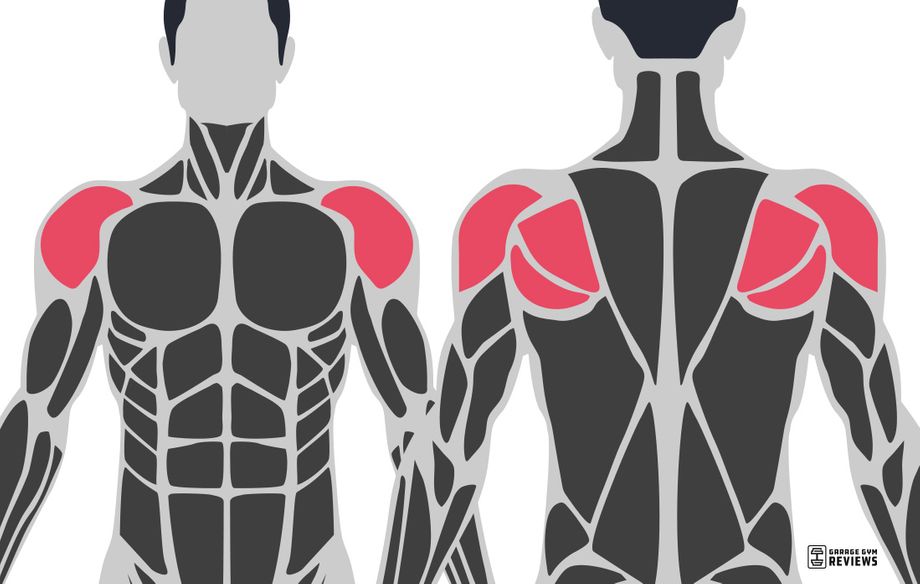
- Trapezius: This trapezoid-shaped muscle stretches from the base of the neck, across the shoulders, and down the spine, where it terminates in the mid-back region. It helps move the shoulder blades, assisting in elevation, depression, and retraction, as well as neck stabilization. The shrug exercise primarily works the upper trapezius.
- Levator Scapulae: The levator scapulae muscles are much smaller than the trapezius, so while they are crucial for the shoulder shrugging movement, you’ll derive much more strength and power from the significantly larger trapezius muscle.
- Shoulder stabilizers: Secondary muscles include the serratus anterior, rhomboids, rotator cuff muscles, and biceps. They’re not directly involved in the shrug movement, but they are integral for stabilizing the shoulder as your primary movers do their thing.
- Forearms: You can’t do the barbell shrug if you can’t physically hold a barbell. Your forearm muscles, namely the brachioradialis, help you keep a strong grip on the bar.
How To Do Shrugs: Final Thoughts
It’s a slight and unassuming movement, but the barbell shrug exercise can provide serious gains. Barbell shrugs:
- Provide activation in the upper back and shoulders
- Are simple to learn and master
- May contribute to better shoulder health
- May reduce neck and back pain
- May translate to improved Olympic weightlifting performance
Don’t shrug us off! Add a few sets of the barbell shrug into your next back and shoulder workout, and start building bigger traps today!
How To Do Shrugs: FAQs
What is the right way to do shrugs?
“The shrug exercise is so simple and slight that some lifters overcomplicate the movement, and it’s almost always to their detriment,” says Kate Meier, NASM-CPT, USAW-L1, CF-L1, and GGR director of fitness content.
To do the shrug exercise the right way, focus on isolating the movement of your shoulders while maintaining a rigid posture throughout the rest of your body.
Should I lean forward when doing shrugs?
For the best results, leaning forward slightly, and we mean slightly, should assist with moving smoothly and getting a good contraction at the top. Make sure you keep your back straight when you tilt forward; the positioning comes from bringing your hips back, not bending your spine or hunching.
How heavy should shrugs be?
Barbell shrugs feature a relatively small range of motion, so you can go heavier than you would on lifts like the bench press or bent-over row. That said, you should never lift a weight that’s too heavy to complete using proper form.
For strength, choose a heavier weight that has you fighting to finish five reps. For hypertrophy or bodybuilding workouts, go a little lighter—about eight to 12 solid reps that makes you really earn the last one or two. For endurance, choose something light and perform sets of 15 to 20 reps.
Don’t be shy about working with a certified personal trainer. They’re not known to shrug their shoulders when you ask what might work best for your goals.
RELATED: Best Online Personal Trainer
References
1. Ekstrom RA, Donatelli RA, Soderberg GL. Surface electromyographic analysis of exercises for the trapezius and serratus anterior muscles. J Orthop Sports Phys Ther. 2003;33(5):247-258. doi:10.2519/jospt.2003.33.5.247
2. Pizzari T, Wickham J, Balster S, Ganderton C, Watson L. Modifying a shrug exercise can facilitate the upward rotator muscles of the scapula. Clin Biomech (Bristol, Avon). 2014;29(2):201-205. doi:10.1016/j.clinbiomech.2013.11.011
3. Cohen SP. Epidemiology, diagnosis, and treatment of neck pain. Mayo Clin Proc. 2015;90(2):284-299. doi:10.1016/j.mayocp.2014.09.008
4. Rahnama L, Saberi M, Kashfi P, Rahnama M, Karimi N, Geil MD. Effects of Two Exercise Programs on Neck Proprioception in Patients with Chronic Neck Pain: A Preliminary Randomized Clinical Trial. Med Sci (Basel). 2023;11(3):56. Published 2023 Sep 8. doi:10.3390/medsci11030056
5. Nagao H, Ishii Y. Characteristics of the Shrug Motion and Trapezius Muscle Activity During the Power Clean. J Strength Cond Res. 2021;35(12):3288-3295. doi:10.1519/JSC.0000000000003355


